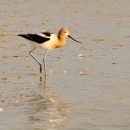Seasons of Wildlife
Spring / Migration
In the spring, Bear River Migratory Bird Refuge is active with life as birds fly back from the south. There is a continuous flow of different species in and out of the Refuge. Each day offers something new. Birds are in their bright and colorful breeding plumage and the observant visitor can witness eons-old courtship rituals. Geese and ducks begin to arrive in early March. Shorebird migration lasts from early April through mid-May.
Summer / Breeding & Nesting
While some birds head further north to breed, over 70 species stay on the Refuge through the summer to breed and raise their young. Baby birds can be seen as early as May when the Canada goose goslings make their debut. Later in June and July, visitors can view ducklings and young shorebirds such as American avocets and black-necked stilts. In July, the sight of young western grebes riding atop their parents' backs is especially exciting.
Fall / Migration
Beginning in late July, shorebirds come back through the Refuge on their way south and numbers peak in mid-August. Up to a half million ducks and geese concentrate on the Refuge units. Over 30,000 tundra swans begin to arrive in mid-October and stay through December.
Winter / Residents & Visitors
From December to March, northern harriers, rough-legged hawks and prairie falcons frequent the marsh, searching the frozen land for prey. Bald eagles use the Refuge in the winter for feeding and resting during the day.
Monthly Bird Happenings
Click on the link to download a PDF indicating some of the most common birds you will see during different times of the year.
Featured Species
The Refuge and other wetlands associated with the Great Salt Lake provide critical habitat for migrating birds from both the Pacific and Central Flyway of North America. This area contains abundant food for birds, including very important brine shrimp and other macroinvertebrates as well as necessary plants like sago pondweed. Birds come to the Refuge by the millions to eat and rest during migration, and many other species stay to breed, nest and raise their young across the Refuge wetlands.
Priority species:
- American Avocet
- Cinnamon Teal
- Black-necked Stilt
- White-faced Ibis
- Shorebirds
- Waterfowl
- Tundra Swan
- Snowy Plover
- Marbled Godwit
- Long-billed Curlew
- American White Pelican
- Redhead
- Wilson's Phalarope
- Long-billed Dowitcher
- Franklin's Gull
- Black Tern
